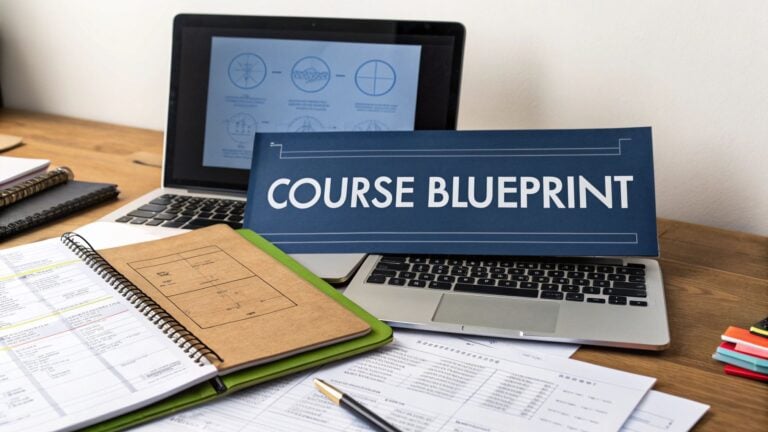How Long Does it Take to Develop an Online Course?
Nowadays, many coaches, tutors, and experts have an online course. They are successfully selling it and reaching many students. It’s a great way to share knowledge and make money.
So, how long does it take to develop an online course? Creating a course can take from a few weeks to several months. The time needed varies based on the course’s length, depth, and how much work you put into it.
To make a good course, you need to plan, make content, and test it. This takes time and effort. But, with dedication, you can create a course that helps others and brings you success.

Factors Influencing Development Time
Many things can change how long the whole process lasts. From the content to how many lessons there are, lots of stuff affects the time needed.
Content Complexity
If the material is deep or covers a lot, it’ll take more time to get right. Courses on specific topics need more digging and know-how, so they take longer compared to more general subjects.
For instance, a basic course on snapping photos is quicker to make than one on advanced photo editing with special software. The developer needs to really understand the topic and create content that's both useful and interesting, which takes a good chunk of time.
General topic courses are a bit easier to whip up.
Course Length
How long a course directly impacts how much time you need to create it. More modules or lessons mean more stuff to make, which means more time. The length of each video or lesson also counts. Longer videos take more planning, recording, and editing time.
A short course with just a few hours of lessons might be quick to put together. But a big course with lots of detailed lessons will naturally take longer. The key is to give enough details without making it boring.
Planning out the course structure well from the start helps manage time better. Breaking the course into smaller parts makes the creation process smoother, even for long courses.
Production Quality
The quality of how the course looks and sounds really matters too. High-quality videos with good editing and graphics take more time and skills. These things make the course look better but also add to how long it takes to make.
Courses with simpler production can be done faster. Still, you have to make sure the quality is good enough so it doesn’t mess up the learning experience. The goal is to find a good middle ground between looking good and not taking forever to make.
Resource Availability
Having the right people and tools can speed up making a course.
It can slow things down if you have to spend time looking for the right info or figuring out tools.
How much time the person making the course can put in also matters. If it’s a side project, it’ll take longer than if they could work on it all day. Juggling other stuff with making the course can make it take longer.
Phases of Online Course Development
Creating an online course goes through several steps. Each phase is important for making sure the course is useful and interesting for learners.
Planning Phase
First up is the planning phase. This is when you decide what you want your students to learn by the end of the course. You figure out the main points and how the course will be set up. It’s like making a map before you start a trip.
In this phase, you outline the course. This means deciding on the chapters or sections and what each part will cover. It’s important to get this right so the course flows well and makes sense to your students.
Content Creation Phase
Next is making the course materials. This involves writing scripts for videos or text lessons and creating any graphics or workbooks your students will need. It’s all about turning your plan into real, usable content.
Recording videos or making interactive stuff comes next. This is where you bring your scripts to life. It can be fun, but it also takes a lot of work to make everything look and sound good.
Review and Revision Phase
After creating content, you check everything. This means looking over the materials to make sure they’re clear and free of mistakes. It’s like proofreading an essay before you hand it in.
Then, you let a small group of people test the course. This is your chance to get feedback and see if there are any parts that need to be better.
Launch Preparation Phase
The last step is getting ready to launch the course. You need to pick where your course will be hosted and how much to charge for it. This is when you decide how to share your course with the world.
Marketing is a big part of this phase. You have to let people know about your course and why they should sign up. This might include things like creating ads, writing blog posts, or posting on social media.
Estimated Timeframes
Here’s the detailed answer on How Long it Take to Develop an Online Course
Short Courses (up to 5 hours)
Short courses are quick to make. You might spend a few weeks on them, from planning to launch. First, you plan what you want to teach and how you’ll do it. This doesn’t take too long since the course is short.
Next, you make your content. Since there’s not a lot of material, you can get this done pretty fast. Recording and writing go quickly if you’re organized.
Marketing for a short course can be straightforward. You tell people what they’ll learn and why it’s worth their time.
Medium Courses (5 to 20 hours)
Medium courses need more time, maybe a couple of months. You start by planning more carefully because there’s more to cover. This phase is about making sure everything fits together well.
Creating content for a medium course takes longer. You’re making more videos and materials. It’s important to keep everything clear and engaging, which takes effort.
Before launching, you review everything and make changes.
Then, you work on getting the word out. This might include more detailed marketing plans to reach the right students.
Comprehensive Courses (20+ hours)
Long courses take the most time, often several months to a year. Planning is key. You think through each part of the course to ensure it all adds up to a great learning experience.
Creating all the content for a long course is a big job. You spend a lot of time writing, recording, and making materials. It’s important to stay focused and keep your students’ needs in mind.
Getting a comprehensive course ready for launch takes careful testing and feedback. Marketing is also more complex. You might use different ways to tell people about the course, aiming to attract students who are ready for a deep dive into the subject.
Final Words
I hope this guide gives you a clear picture of what it takes to make an online course. Whether you’re working on a short, medium, or long course,
From planning to launching, each step needs your attention and effort. Don’t rush. Take the time needed to create something valuable for your learners.






